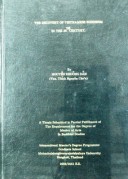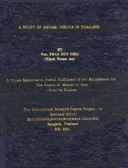Tìm Sách
Luận Văn - Thesis - Tiểu Luận >> The Recovery of Vietnamese Buddhism in the 20th Century
Thông tin tra cứu
- Tên sách : The Recovery of Vietnamese Buddhism in the 20th Century
- Tác giả : Thich Nguyen Chon- (Nguyen Khuong Dan)
- Dịch giả : Nguyen, Khuong Dan
- Ngôn ngữ : Anh
- Số trang : 98
- Nhà xuất bản : Graduate-Thailand
- Năm xuất bản : 2008
- Phân loại : Luận Văn - Thesis - Tiểu Luận
- MCB : 1210000008283
- OPAC :
- Tóm tắt :
ACKNOWLEDGMENTS
This is a good opportunity for me to express my deep thanks to Venerable preceptor, professors, teachers, advisors, dharma friends, sponsors and others who have brought me a good chance to make my study at Mahachulalongkomrajavidyalaya University of Thailand.
Firstly, being a son, I want to show my great gratitude to my parents who took care of me carefully and encouraged me to go on a noble way of a Buddhist monk.
Secondly, being a monk, I want to express my deep gratitude to Venerable Thích Tâm Phương – my preceptor, Venerable Thích Minh Thông, Venerable Thích Trí Viên and all masters of Khánh Hòa Intermediate Buddhist School, who has brought me up in the light of the Buddha Teachings.
Furthermore, I would particularly like to express my profound thanks to all teachers, professors, lecturers of Mahachulalongkom-rajavidyalaya University who have taught and supported me scholarship to do my M.A degree at this university.
The next, I wish to extend my thanks to venerable Profesors of Vietnam Buddhist University especially the most Venerable Rector Dr. Thích Minh Châu, Vice — rector Dr. Lê Manh Thát, Dr. Thích Nhật Từ for their help and encourage me during the time I have studied in Thailand.
Additionally, I want to express my gratitude to my supervisors Ven. Dr. Phra Suthithammanuwat, Prof. Dr. Lê Mạnh Thát and Prof. Dr. Veerachart Nimanong for their valuable advice and suggestions from the beginning to end of my Thesis.
Moreover, I would like to show my deep gratitude to the Most Venerable Phra Samananam Theerajhan (Thích Tịnh Liên), abbot of Wat Sammananamborihan, Sapankhao, Bangkok, who supported me an accommodation during the time I made my study in Thailand.
I also never forget to thank Mae Chee Tansomboon who helped me find temple, spiritually encouraged me as well as shared valuable experiences on correcting my thesis’s format.
My special thanks to laywoman Thu Trang, Giác Diệu, layman Thừa Bửu and all members of Mr. Trung Kiên’s family who have supported me during the time I have studied abroad.
Last but not least, I never forget to thank so much and highly appreciate authors of books, magazines, newspapers that I adapted from, without their contributions my thesis could not have been completed.
Bangkok, Winter 2008
Nguyễn Khuông Dần
TABLE OF CONTENTS
Approval Page…………………i
Abstract…………………ii
Acknowledgements…………………iv
List of Abbreviations…………………vi
Table of Contents…………………vii
Chapter I: Introduction
1.1 Background and Significance of the Problem…………………1
1.2 Objectives of the Study…………………3
1.3 Statement of Problem…………………4
1.4 Definitions of the Terms…………………4
1.5 Review of the Related Literatures…………………5
1.6 Method of the Study…………………6
1.7 Expected Finding and Benefits of the Study…………………6
Chapter II: The Brief History of Vietnamese Buddhism from Early Beginning up to the 20th Century
- From Early Beginning to the Independent Nation of Vạn Xuân Founded by Lý Nam Đế (544). …………………7
2.1.1 Ways and Years of Buddhist Entering…………………7
2.1.2 Luy Lâu Buddhist Center…………………10
2.1.3 The Buddhist Situation in the First Period…………………10
2.1.4 Typical Representatives and Setting of Buddhism from the 2nd and 3th Centuries…………………11
2.1.5 Vu Pháp Lan, Vu Đạo Thúy and Buddhism in the Fourth Century………13
2.1.6 Đạo Cao, Pháp Minh, Lý Miễu through the Appearance of ‘Six Letters’ and Buddhism in the Fifth Century……………14
2.1.7 Huệ Thắng, Đạo Thiền and the End of ‘Magic Buddhism’…………15
2.2 From Vinitaruci Thien School to King Lý Thái Tông (1054)…………16
2.2.1 Vinitaruci School…………………17
2.2.2 Vô Ngôn Thông School…………………18
2.2.3 Practicing Method of the Vô Ngôn Thông School…………………19
2.2.4 Some Features of Buddhism from the Period of King Lý Nam Đe to King Lý Thái Tông…………………20
2.2.4.1 Movement – Going to India to Study Abroad…………………20
2.2.4.2 Movement – Going to China for Preaching Dharma…………………21
2.2.4.3 Using Prophetic or Oracle Practice to Nurture the National Conscience of Independence and a Rare Victory by Non-Violent Revolution in History……21
2.3 From King Lý Thánh Tông (1054) to King Tran Thánh Tông (1278)……22
2.3.1 The Appearance of the Thảo Đường Thiền School in the Lý Dynasty……22
2.3.2 Practice Method of Thảo Đường…………………23
2.3.3 Some Features of Buddhism in This Time…………………24
2.4 From King Trần Nhân Tông (1278) to Lord Nguyễn Phúc Thái ………25
2.4.1 The Trúc Lâm Thiền School: The Independent and United Vietnamese School of Thiền…25
2.4.2 The Essential Characteristics of the Trúc Lâm Meditation School……26
2.4.3 Master Pháp Loa, Huyền Quang and Kim Sơn …………………28
2.4.4 Buddhist Situation after the kim Son’s Period …………………30
2.4.5 Buddhism in the 15th and 16th Centuries …………………31
2.5 From Lord Nguyễn Phúc Chu to Early 20th Century …………………32
2.5.1 Buddhist Traditions in Lord Ngụyễn Phúc Chu’s Age …………………33
2.5.2 Tào Động Thiền School (C. T’sao Tung) …………………34
2.5.3 Lâm Tế Thiền School (C. Lin Chi) …………………34
2.5.4 Master Chân Nguyên, Minh Châu Hương Hải in the North …………………35
2.5.5 The Crisis of Vietnamese Society in the Nguyễn Dynasty and Buddhist Reactions ……36
Chapter III: The Recovery of Vietnamese Buddhism in the 20th Century
3.1 Problem and Significance of the Recovery…………………40
3.2 The Political and Social Setting Leading to the Buddhist Recovery in Vietnam………41
3.2.1 Reasons of the Recovery in Vietnam…………………44
3.3 Initiators of the Recovery…………………48
3.4 The Buddhist Recovery in the South…………………51
3.5 The Buddhist Recovery in the Centre…………………56
3.6 The Buddhist Recovery in the North…………………59
3.7 Southern Buddhist Movement in 1963 and the Self – Immolation of Bodhisattva Thích Quảng Đức…………………61
3.8 Forming of Buddhist Sangha…………………66
3.8.1 The Vietnam Theravãda Congregation…………………66
3.8.2 The Unified Buddhist Church…………………68
3.8.3 The Vietnam Buddhist Sangha…………………68
3.8.4 Buddhist Nun Order…………………70
3.8.5 The Other Buddhist Associations…………………72
3.8.5.1 Vietnam Buddhist Family…………………72
3.8.5.2 Khất sĩ Buddhism…………………73
3.8.5.3 Caodaism…………………74
3.8.5.4 Hoahaoism…………………75
Chapter IV: The Doctrinal Development of Vietnamese Buddhism in the 20th Century
4.1 The Movement of Learning Quốc Ngữ…………………77
4.1.1 Tipitaka Translation…………………79
4.1.2 Buddhist Magazines and Newspapers on Quốc Ngữ…………………79
4.2 Development in Education and Training…………………80
4.2.1 Buddhist Study in Present Years…………………82
4.2.2 The Institute of Higher Buddhist Studies…………………83
4.2.3 The Vietnam Buddhist University…………………83
4.2.4 Training and Propagating…………………84
4.2.5 Dharma Schools for Laypeople…………………85
4.3 The Development of Practice Methods…………………85
4.3.1 Trúc Lâm Thiền School…………………85
4.3.2 Meditation Centers of Theravãda Buddhism…………………85
Chapter V: 5.1 Conclusions and Suggestions
5.1 Conclusions…………………88
5.2 Suggestions for Further Research…………………89
Bibliography…………………91
Biography of Researcher…………………97
 Facebook
Facebook
 Google
Google
 Google+
Google+











